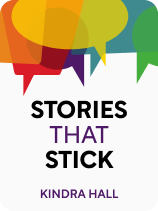

This article is an excerpt from the Shortform book guide to "Stories That Stick" by Kindra Hall. Shortform has the world's best summaries and analyses of books you should be reading.
Like this article? Sign up for a free trial here.
What are the four components of storytelling? How do you tell a good story that wows your audience?
For a story to make an impact, it has to be a good one. Thankfully, according to Kindra Hall’s book Stories That Stick, there’s a simple recipe for crafting a compelling story.
Keep reading to learn how to tell a good story with these four key components.
The Four Components of a Good Story
According to Hall, you must have four key components to learn how to tell a good story:
First, good stories have a character that you’re rooting for—someone your audience can care about. The thing you’re selling, whether it’s financial consulting or the latest electric toothbrush, doesn’t count as a character because people can’t relate to a toothbrush. Make sure your story centers on a character that people empathize with.
Second, good stories rely on concrete details to paint a picture for the listener. This helps transport the listener to the world of the story, especially if those details are relatable and help the listener recall moments or details from their own life. For example, if you’re speaking to an audience born in the ’80s or ’90s, you might make a small reference to shared cultural experiences like Blockbuster or mix tapes.
Third, good stories are rooted in genuine emotion. While your story doesn’t have to be overdramatic, it does have to hold emotional weight. Otherwise, it doesn’t matter how the story ends. Make sure the audience has an emotional stake in the outcome.
Finally, good stories need a moment where something changes—a turning point. Stories without this pivotal moment are boring because they drift aimlessly without a clear purpose.
| The Definition(s) of a Good Story There’s no single definition of a good story, as evidenced by the varied definitions put forth by marketing experts. In Unleash the Power of Storytelling, Rob Biesenbach defines a good story simply as an account of a character who pursues a goal and encounters obstacles along the way. While, like Hall, he highlights the importance of a central character that experiences change, he doesn’t focus as much on the need for concrete details or genuine emotion. Daniel Pink, on the other hand, focuses primarily on the emotional impact of a story. In A Whole New Mind, he explains that a good story must elicit empathy in the reader and speak to a genuine experience. This definition is a variation of the ideas presented by Joe Lazauskas and Shane Snow, authors of The Storytelling Edge, who argue that a good story is authentic and emotionally engaging. Finally, in All Marketers Are Liars, Godin avoids defining a good story altogether, instead emphasizing that a good story depends on your audience as it must appeal directly to their worldview. |
The Story Sequence
Now that you have the four elements of a strong story, you need a way to tie them all together. We’re taught from an early age that good stories have a beginning, a middle, and an end. But Hall recommends reimagining this three-part structure as a before (what she calls “the normal”), the change (“the explosion”), and the after (“the new normal”). This structure focuses on introducing tension or conflict that’s then resolved, thereby creating an engaging and more memorable story.
While often overlooked, the beginning of the story is critically important. In order to be emotionally invested in your story, your audience needs to know what the world looked like before everything changed. Your audience will be even more invested if that world, or the characters, is familiar to them. As you begin your story, introduce the characters and add the details that will help your audience connect to the world you’re describing. For example, if you’re speaking to a group of millennials, you could incorporate a reference to ’90s pop music or college debt—any detail that allows the listener to see themselves in your story.
The next part of the story is the moment when everything changes. It doesn’t matter whether the change in your story is good or bad; your story needs a moment where something happens that marks a difference between what happened before and what happens after. Otherwise, the story will be stagnant.
In the final part of the story, you describe what happens after the change—how does the central character or the world look different after the change, or how could it look different? For example, after someone buys your product, how is their life better?

———End of Preview———
Like what you just read? Read the rest of the world's best book summary and analysis of Kindra Hall's "Stories That Stick" at Shortform.
Here's what you'll find in our full Stories That Stick summary:
- Why stories are probably the answer to most of your business problems
- How to harness the power of storytelling to connect with your audience
- How to integrate storytelling into your marketing strategy






